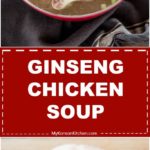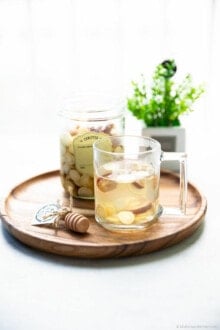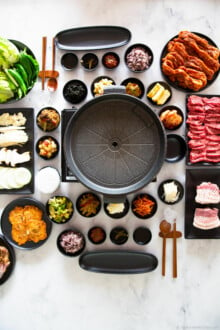Restore your energy with Samgyetang (Korean Ginseng Chicken Soup)! It’s a popular summer stamina food in Korea.
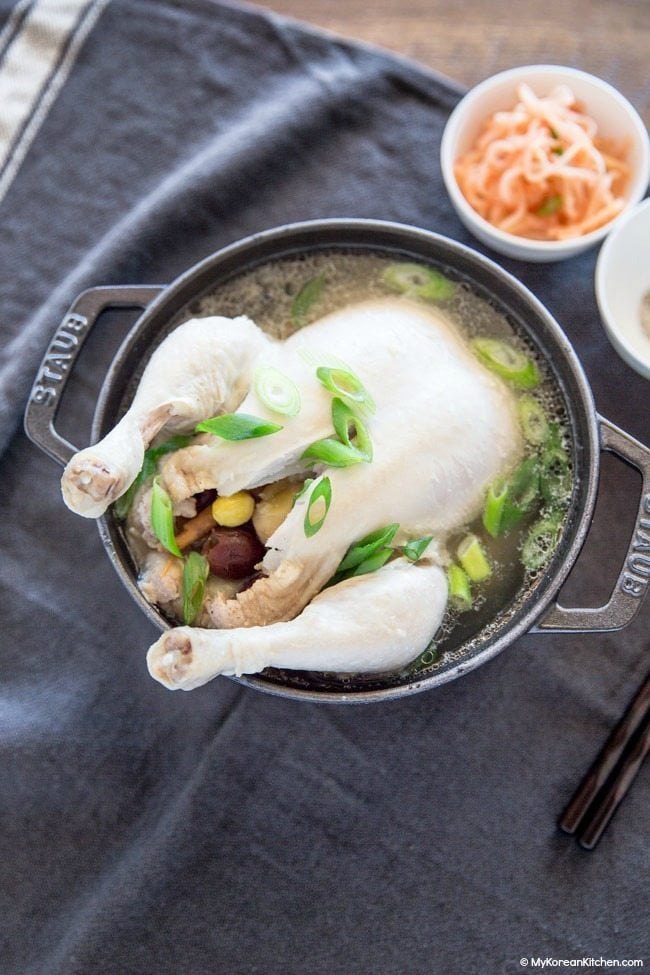
Today, I’m sharing a samgyetang recipe. Samgyetang (삼계탕, 蔘鷄湯) means ginseng chicken soup and it is a popular stamina food in summer.
Korean ancestors believed that you can supplement your lost energy by having this soup. So many Koreans visit Samgyetang restaurants in summer, particularly during the three hottest days of summer (also known as three dog days of summer). And, the first one is coming up next week – July 12th this year!
Even though samgyetang is a popular summer food, I think it’s a perfect soup even in winter (or any other cooler season) simply because it’s warm and gives you nice soothing comfort.
My family’s been really enjoying this soup in the last few weeks and that really made me pleased. I was never a huge fan of it, but I really do love my homemade samgyetang! It’s very light, healthy and tastes nutritious.
I hope you give this recipe a try soon for your family too. Hope you all like it and feel healthy!
P.S Make sure to read my additional tips at the end of the recipe before trying it out!
P.P.S If you like this recipe, you may want to try Ginseng Tea and Korean Chicken Noodle Soup recipe.
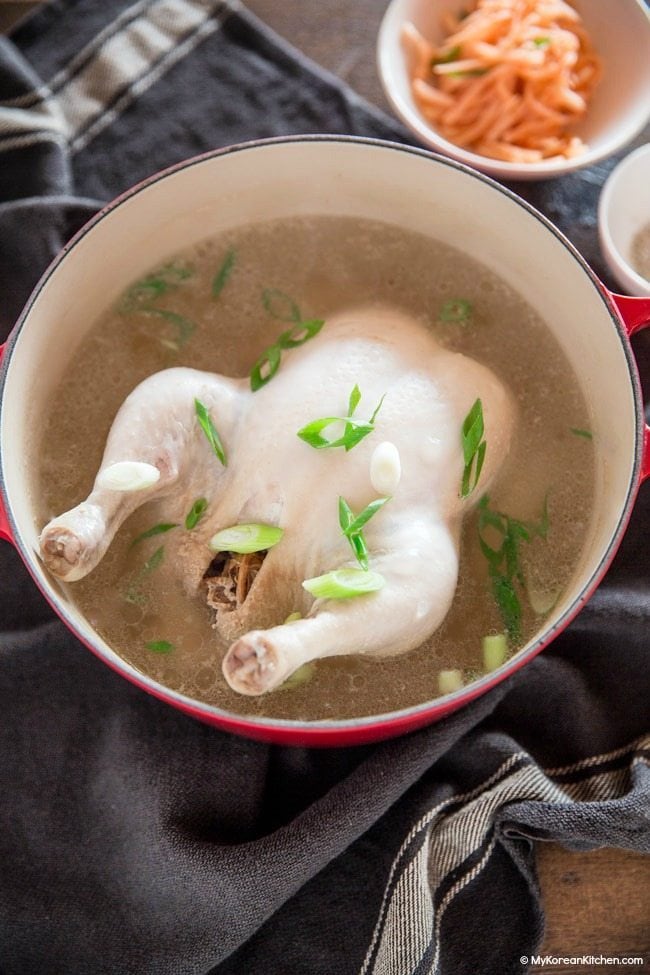
Ingredients for Samgyetang (Korean Ginseng Chicken Soup), Serves 3 to 4
Broth
- 1.2 kg / 2.6 pounds whole chicken, if you can, try to use cornish chicken as the typically recommended chicken size for samgyetang is about 400 g / 0.9 pounds per serving. However, I couldn’t find it, so I just used the smallest whole chicken I could find.
- 1.5 liter water
Stuffing
- 1/4 cup sweet rice (mochi rice or sticky rice), soaked in water for 2 hours (this can be done overnight and kept in the fridge)
- 1 dried or fresh Korean ginseng or American ginseng (I used 15 g of dried ginseng)
- 4 whole garlic cloves, peeled
- 5 dried jujube
- (optional) 3 to 4 ginko nuts, peeled if not already
- (optional) 3 to 4 fresh or frozen chest nuts, peeled if not already
Garnish & To serve
- 1 to 2 Tbsp green onion, thinly sliced
- fine sea salt, to taste
- ground black pepper, to taste
*1 Tbsp = 15 ml, 1 Cup = 250 ml
How to Make Samgyetang (Ginseng Chicken Soup)
1. Wash the chicken (including the cavity) thoroughly under running cold water.
2. Stuff the chicken cavity with sweet rice, ginseng, garlic cloves, jujube, gingko nuts, and chest nuts. Cross the chicken legs and tie them with a cotton tie. Alternatively, you can make a slit on one side of the chicken thigh skin and put the other leg through it. (It sounds difficult but it’s not!) This is to minimise the stuffed ingredients falling out.
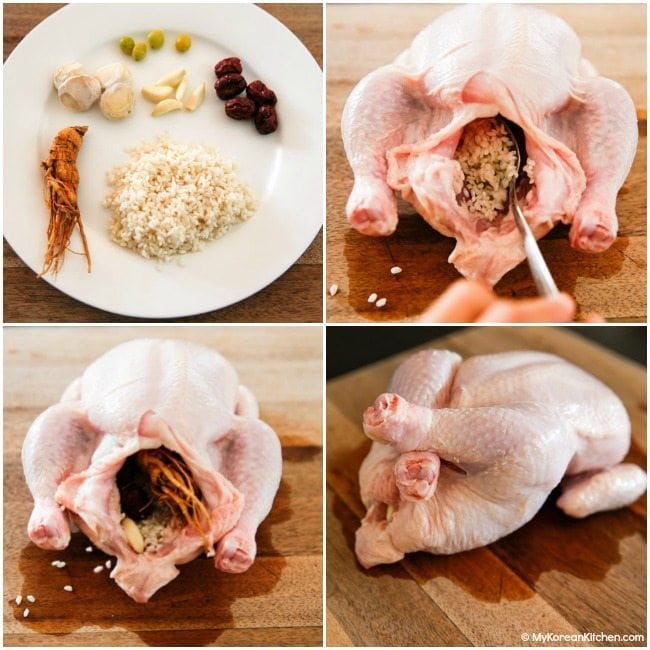
3. Pour the water into a large pot and add the stuffed chicken. Boil the pot over medium high heat, covered, for 20 mins. Reduce the heat to medium to medium low and boil further until the chicken is fully cooked (about 30 mins further). Also, make sure the stuffed sweet rice is fully cooked too. Skim off any scum as desired.
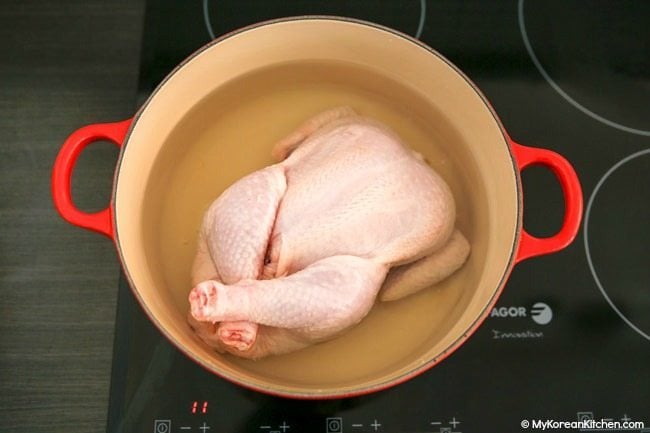
4. Transfer the chicken and the soup into a serving bowl. Garnish with the green onion and serve. Also, serve a small plate of salt and black pepper mixture (one plate per person). You can dip your chicken pieces into this sauce or add to your soup as desired. (Finally, don’t forget to serve some Kimchi too!)
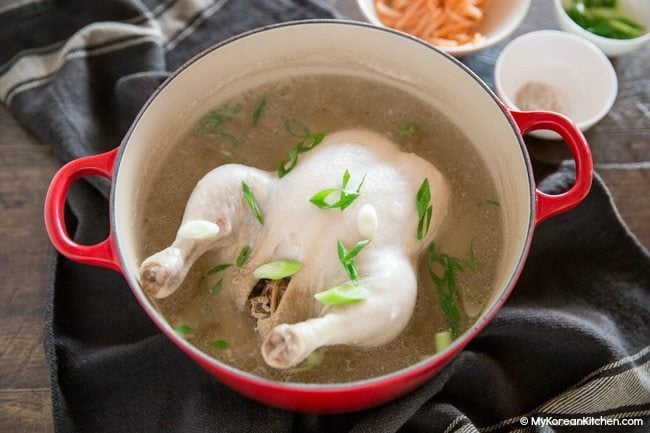
Additional Tips for Making Samgyetang at Home
- Finding ginseng whether it’s fresh or dried can be quite challenging, at least that was the case for me! I was “lucky” enough to find some dried American ginseng. FYI, Korean giseng and American ginseng have different medicinal benefits. So you may want to read up about the differences prior to going shopping.
- If you’re using a dried ginseng root, soak it overnight in water. I normally soak it in 500 ml / 2 cups of water then use this water in the broth. (So I would use 1 liter fresh water and 500 ml ginseng soaked water). But even after cooking, dried ginseng are not edible. It’s very hard and woody. So I would choose fresh ginseng over dried ginseng if I have a choice.
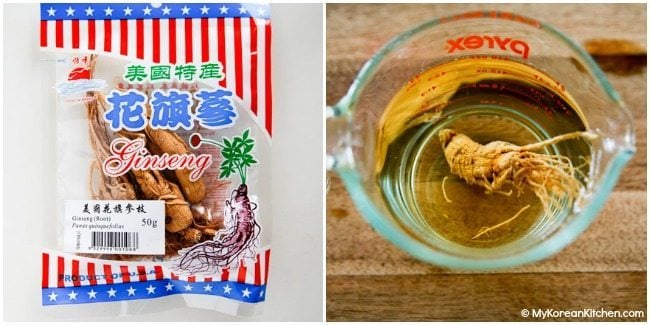
- While ginseng is harder to find, finding “samgyetang kit” from a Korean grocery store might be relatively easy. Some of these packages may include ginseng but I haven’t come across one yet. Instead, it will be filled with different types of herbal ingredients (as shown below) such as milk vetch root. If you are using this kit, use this prior to step 3 and this is what you need to do. -> Boil the water in a pot. Once the water is rolling boiling, add the herbal ingredients and boil them over medium high heat until the water changes to yellow / light brown from the herbal ingredients. Take them out and discard. Add the stuff chicken and follow the remaining steps as above. Alternatively, follow the package instructions.
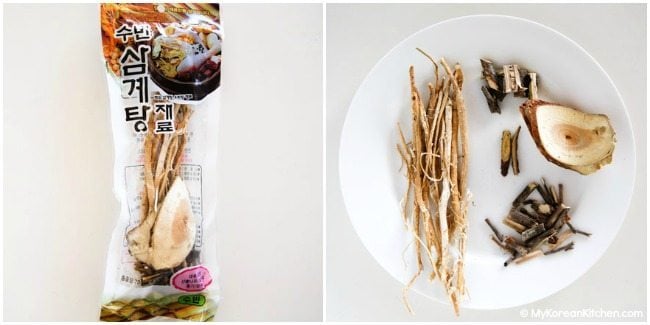
- You could debone the whole chicken after cooking but prior to serving for the convenience of individuals. (This is how we serve it at home and it’s usually my hubby’s job. 🙂 )
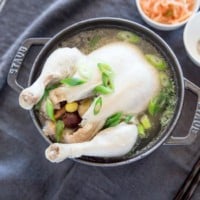
Samgyetang (Ginseng Chicken Soup)
Ingredients
BROTH
- 1.2 kg whole chicken if you can, try to use cornish chicken as the typically recommended chicken size for samgyetang is about 400 g / 0.9 pounds per serving. However, I couldn’t find it, so I just used the smallest whole chicken I could find.
- 1.5 liter water
STUFFING
- 1/4 cup sweet rice (mochi rice or sticky rice), soaked in water for 2 hours (this can be done overnight and kept in the fridge)
- 1 ginseng , dried or fresh Korean ginseng or American ginseng (I used 15 g of dried ginseng)
- 4 whole garlic cloves , peeled
- 5 dried jujube
- 4 ginkgo nuts (optional), peeled if not already
- 4 chest nuts (optional), fresh or frozen, peeled if not already
GARNISH & TO SERVE
- 1 Tbsp green onion , thinly sliced
- fine sea salt , to taste
- ground black pepper , to taste
Instructions
- Wash the chicken (including the cavity) thoroughly under running cold water.
- Stuff the chicken cavity with sweet rice, ginseng, garlic cloves, jujube, gingko nuts, and chest nuts. Cross the chicken legs and tie them with a cotton tie. Alternatively, you can make a slit on one side of the chicken thigh skin and put the other leg through it. (It sounds difficult but it’s not!) This is to minimise the stuffed ingredients falling out.
- Pour the water into a large pot and add the stuffed chicken. Boil the pot over medium high heat, covered, for 20 mins. Reduce the heat to medium to medium low and boil further until the chicken is fully cooked (about 30 mins further). Also, make sure the stuffed sweet rice is fully cooked too. Skim off any scum as desired.
- Transfer the chicken and the soup into a serving bowl. Garnish with the green onion and serve. Also, serve a small plate of salt and black pepper mixture (one plate per person). You can dip your chicken pieces into this sauce or add to your soup as desired. (Finally, don’t forget to serve some Kimchi too!)
Notes
Nutrition Info (per serving)
The nutrition information shown is an estimate provided by an online nutrition calculator. It should not be considered a substitute for a professional nutritionist’s advice.
